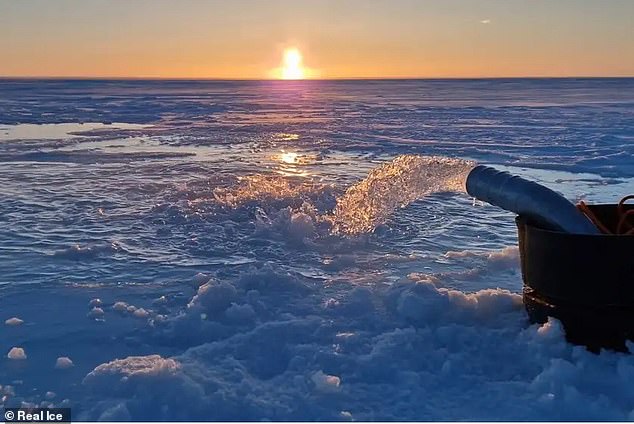When it comes to curbing climate change, scientists will try almost anything.
And experts at the University of Cambridge are no exception – as they have been given funding to see if global warming could be slowed by refreezing the Arctic.
A team will explore whether the Arctic’s rapidly diminishing sea ice could be artificially thickened by pumping seawater onto the surface in winter.
If successful, it could reduce summer melt and slow regional warming, they said.
For years, scientists have sounded the alarm over the Arctic’s rapidly-shrinking sea ice cover.
Many expect the region to be ice-free in the summer in the 2030s, even if sharp cuts to emissions are made immediately.
Some researchers say the only way to stop this from happening is to artificially thicken the ice – which polar wildlife and Inuit communities depend on.
But how, exactly, would it work?

Surface thickening works by pumping seawater directly onto the surface of ice, which freezes and thickens the ice from above

Thanks to rising global temperatures, Arctic sea ice has retreated well north of its 1981-2010 average extent (shown as pink)

In the North Pole, climate change has caused melting ice caps and reduced polar ice extent (stock image)
Sea ice forms naturally by water freezing on the bottom of existing ice which floats on the ocean’s surface.
As the ice grows it becomes a thicker insulating layer between the cold Arctic air above the ice and the water below, so the rate of freezing slows down.
Any snow on the ice’s surface also acts as an insulator, further slowing the rate of new ice growth.
One technique that Cambridge’s Centre for Climate Repair is looking into is called surface thickening.
This aims to increase the sea ice thickness directly when there is no snow by pumping seawater onto the surface, so it is directly exposed to the cool atmosphere and thickens the ice from above.
Another method can be used when there is snow on the surface of the ice. It involves filling the voids of air within snow with seawater – eventually turning the snow into solid ice which then leads to more natural freezing at the ice’s base.
Field trials are set to begin in Canada this year in collaboration with Real Ice, whose mission is to ‘preserve and restore Arctic Sea Ice’.
Last year the company said tests have validated the idea, with a pilot borehole thickening the ice shelf by 50 centimetres compared with a control site between January and May.

The Arctic’s sea ice hit its second lowest extent on record for January this year, with the ice extent down 498,000 square miles (1.29 million square kilometres) compared to the 1981 to 2010 average (file photo)

The Real Ice team testing out their method in Canada. The technique was first proposed in 2016, and experts believe that deploying ice thickening over 10 per cent of the Arctic could successfully reverse ice loss in the region
Crucially, the results show that the technique triggered 25 cm of natural ice growth on the underside of the ice shelf.
The method was first proposed by Steven Desch at Arizona State University and his colleagues in 2016.
They estimated that deploying ice thickening over 10 per cent of the Arctic could more than reverse recent ice loss in the region.
‘Our objective is to demonstrate that ice thickening can be effective in preserving and restoring Arctic sea ice,’ Andrea Ceccolini, from Real Ice, previously told New Scientist.
‘Every action we can take to make the ice last longer during the summer will give us extra weeks of solar radiation reflection back to space, which is less energy absorbed by the planet.’
The scheme is one of 21 geo-engineering projects that will receive a total of £57 million in UK taxpayer money to assess a range of controversial techniques to curb the effects of global warming.
The funding comes from the government’s Advanced Research and Invention Agency (Aria).
This article was originally published by a www.dailymail.co.uk . Read the Original article here. .

